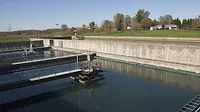United States Using Less Water than 35 Years Ago
Despite a 30 percent
population increase during the past 25 years, overall water use has remained
fairly stable, according to a new U.S. Geological Survey (USGS) report.
The United States is using less water than during the peak years of 1975 and 1980, according to water-use estimates for 2005. The report shows that in 2005 Americans used 410 billion gallons per day, slightly less than in 2000. The declines are attributed to the increased use of more efficient irrigation systems and alternative technologies at power plants. Water withdrawals for public supply have increased steadily since 1950 – when USGS began the series of 5-year trend reports – along with the population that depends on these supplies.
Nearly half (49 percent) of the 410 billion gallons per day used by Americans was for producing electricity at thermoelectric power plants. Irrigation accounted for 31 percent and public supply 11 percent of the total. The remaining 9 percent of the water was for self-supplied industrial, livestock, aquaculture, mining and rural domestic uses.
“Because electricity generation and irrigation together accounted for a massive 80 percent of our water use in 2005, the improvements in efficiency and technology give us hope for the future,” Castle says. “The report also underscores the importance of recognizing the limits of the drinking water supplies on which our growing population depends. While public-supply withdrawals have continued to increase overall, per capita use has decreased in many States during recent decades.
The water-use estimates are broken down by state, source and category of water use. California, for example, is one of four states – joining Texas, Idaho and Florida – that accounted for more than one-fourth of all fresh and saline water withdrawn in the United States in 2005.
The largest uses of fresh surface water were power generation and irrigation, and the states with the largest fresh surface water uses were California, Texas, Idaho and Illinois. The largest use of fresh ground water was irrigation, and the states with the largest fresh ground water uses were California, Texas, Nebraska and Arkansas.
The majority of irrigation withdrawals and irrigated acres are in the western states, but significant increases in irrigation have occurred in some southeastern states. Irrigation application rates have decreased steadily from 1950 to 2005, and this decline is attributable to the increased use of more efficient irrigation systems.
The full report is available at http://pubs.usgs.gov/circ/1344.
The United States is using less water than during the peak years of 1975 and 1980, according to water-use estimates for 2005. The report shows that in 2005 Americans used 410 billion gallons per day, slightly less than in 2000. The declines are attributed to the increased use of more efficient irrigation systems and alternative technologies at power plants. Water withdrawals for public supply have increased steadily since 1950 – when USGS began the series of 5-year trend reports – along with the population that depends on these supplies.
Nearly half (49 percent) of the 410 billion gallons per day used by Americans was for producing electricity at thermoelectric power plants. Irrigation accounted for 31 percent and public supply 11 percent of the total. The remaining 9 percent of the water was for self-supplied industrial, livestock, aquaculture, mining and rural domestic uses.
“Because electricity generation and irrigation together accounted for a massive 80 percent of our water use in 2005, the improvements in efficiency and technology give us hope for the future,” Castle says. “The report also underscores the importance of recognizing the limits of the drinking water supplies on which our growing population depends. While public-supply withdrawals have continued to increase overall, per capita use has decreased in many States during recent decades.
The water-use estimates are broken down by state, source and category of water use. California, for example, is one of four states – joining Texas, Idaho and Florida – that accounted for more than one-fourth of all fresh and saline water withdrawn in the United States in 2005.
The largest uses of fresh surface water were power generation and irrigation, and the states with the largest fresh surface water uses were California, Texas, Idaho and Illinois. The largest use of fresh ground water was irrigation, and the states with the largest fresh ground water uses were California, Texas, Nebraska and Arkansas.
The majority of irrigation withdrawals and irrigated acres are in the western states, but significant increases in irrigation have occurred in some southeastern states. Irrigation application rates have decreased steadily from 1950 to 2005, and this decline is attributable to the increased use of more efficient irrigation systems.
The full report is available at http://pubs.usgs.gov/circ/1344.
Looking for a reprint of this article?
From high-res PDFs to custom plaques, order your copy today!




